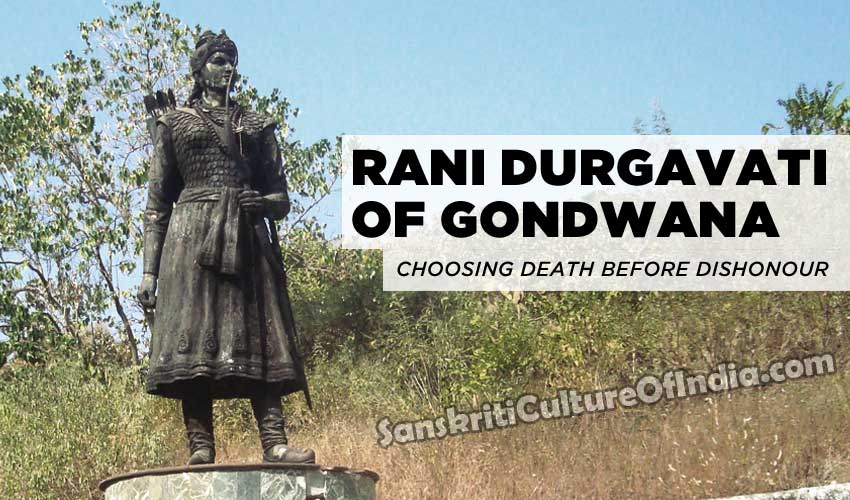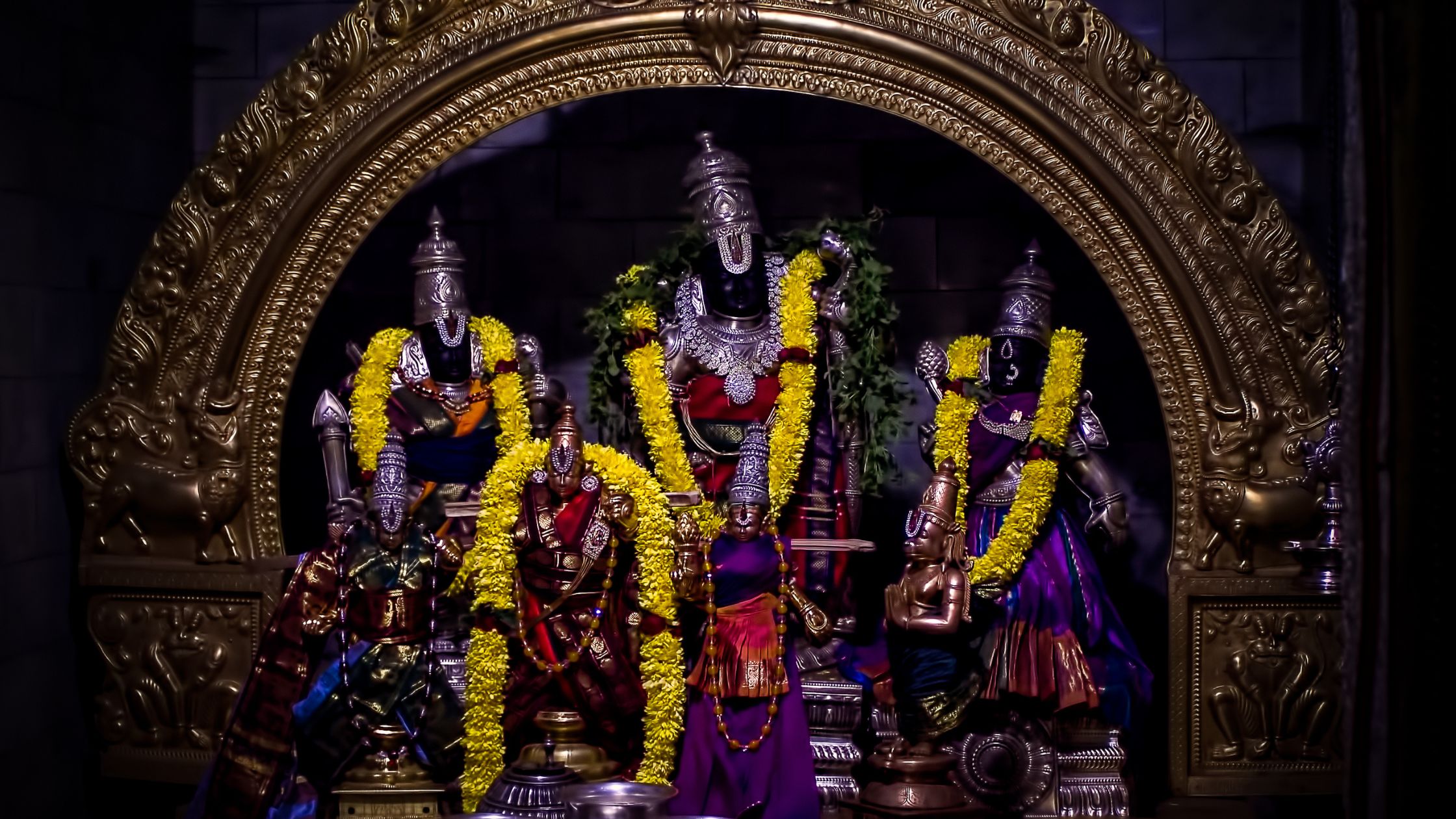Rani Durgavati was born October 5, 1524, at the fort of Kalanjar (Banda, U.P.). She was descended from the Chandel emperor Vidyadhar, a doer of great deeds: he was one of the few Indian kings to successfully repulse Mahmood Ghaznavi, who first invaded India in the closing years of the 12th Century.
In the West, the Chadel Dynasty is best known for building Khajuraho, where 85 temples – of which 22 survive – celebrated, among other themes, the principle of Eros.
In 1542, Durgavati was married to Dalpatshah, the eldest son of the Gond king Sangramshah. This united the Chandel and Gond dynasties, and enabled her father, the Chandel king Keerat Rai, to get help from the Gonds at the time Shershah Suri invaded.
Durgavati gave birth to a son, Vir Narayan, in 1545 A.D. Dalpatshah died in about 1550 A.D. As Vir Narayan was too young at that time, Durgavati took over the throne. She was helped by two dedicated ministers, Adhar Kayastha and Man Thakur. Her administration saw an enhancement of economic and cultural life for her subjects; by all accounts, she was an effective ruler. The Rani moved her capital to Chauragarh from its traditional location at Singaurgarh. Chauragarh was a fort of strategic importance situated in the Satpura hill range.
After ascending to the throne, he attacked Rani Durgavati but she repulsed him, inflicting heavy losses to his army. This defeat effectively silenced Bajbahadur and the victory brought name and fame for Rani Durgavati.
Rani’s contemporary Mughal Subedar was Abdul Mazid Khan, an ambitious man who vanquished Ramchandra, the ruler of Rewa. During Mughal times, a subedar was the highest-ranking provincial deputy of his emperor.
The riches of Rani Durgavati’s state drew Abdul Mazid Khan’s attention. He sought and gained permission from Akbar to attack the Rani. Akbar’s interest in the invasion was his wish to expand his rule over Central India. Rani Durgavati’s was a personality with varied facets. She was valiant, beautiful and brave and also a great leader with administrative skills. Her self-respect forced her to fight till death rather than surrender herself to her enemy.
Three Battles
The short campaign between Rani Durgavati and Asaf Khan developed in the three phases.
Her resources permitted her to fight only a defensive battle. Accordingly, in the first phase she drew up her forces at Narrai. The place was protected by hills on one side, and the rivers Gaur and Narmada on the other. Thus, her forces were in no danger of being outflanked.
The natural strength of the position permitted her to defeat a force much larger and much better trained and armed. But at first she had to overcome a major setback: her leading general, Fauzdar Arjun Daswas was killed in the initial stages of battle. Rani Durgavati herself took charge, attacking the adversary columns from both sides as they entered the valley. This classic maneuver gave her the first victory.
In the process of pushing back the attacker, the Rani’s forces emerged from the valley and were, at nightfall, in open positions. A better general than her male officers, after a review of strategy with her counselors, she decided on a night-attack. Unfortunately, the men would not agree and prevailed on her to stand where she was. Readers will recognize in the strategy conducted the standard manner in which Indian armies fought, and why they suffered so many defeats over the centuries.
Sure enough, the adversary general, Asaf Khan, used the night to bring up reinforcements, including his heavy artillery. Thus the stage was laid for the second phase.
The Rani’s son, Vir Narayan, despite his youth led the army in three charges, pushing back the Mughal army each time. We may be certain that these attacks were conducted in the usual brave and reckless manner the Hindus of the times fought, with no attempt to outflank the frontal defenses. Though we lack evidence, it is reasonable to suppose the three charges actually strengthened the Mughals because they were pushed back on themselves and their army became a more coherent and compressed mass.
At this point Vir Narayan was wounded by an adversary arrow, and forced to retreat from the battlefield. His mother, Rani Durgavati immediately came up on her elephant, named Sarman, to take charge, and thus held the Hindu army together.
Unfortunately now great misfortune struck: she was hit by two arrows, one through her jaw near the ear, and the other through her neck. She lost consciousness, and when she regained it, she saw immediately the battle was about to be lost. The mahout of her battle elephant pleaded with her to let him take her back to safety. That meant acknowledging the inevitable defeat and surrender.
Instead of retreating, she killed herself with a dagger. It was the 24th day of June in 1564.
Now came the third phase of the battle. The son, Vir Narayan, retreated to one of the two strongest forts in his country, at his capital Chauragarh, and locked himself in to no avail; the Mughal Army took the fort, and Vir was killed.
Akbar offered the Kingdom of Gadha to Chandra Sah. The latter accepted Akbar’s over-lordship and swore his fealty as a vassal.
An enormous booty was taken by the victors and divided between the emperor and the victors according to the custom of the times.
In itself Rani Durgavati’s attempt to preserve the kingdom for her son was not a major event in the history of those times. Her real importance lies in her becoming an icon, three and four centuries later, for the Indian independence movement.
At the same time, we should consider that at the time, Indians did not think of themselves as a Hindu state/s overrun by Muslims. Men of both faiths fought their co-religionists. Commanders, princes, generals, and kings were motivated by local politics, not by theology: they made alliances and broke alliances on tactical and strategic grounds, not on religious considerations. India continued to be known as Hindustan, the land of the Hindus, even after the arrival of Islamic kings who ruled the sub-continent for seven hundred years; the Mughal ruler Akbar was the King of Hindustan.
In the year 1983, the Government of Madhya Pradesh renamed the University of Jabalpur as Rani Durgavati Vishwavidyalaya in her memory. Government of India paid its tribute to the valiant Rani by issuing a postal-stamp commemorating her martyrdom, on 24th June 1988.











